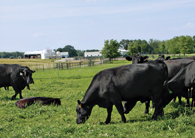Keep 'em Moving

|
Follow these links to detailed information on rotational grazing and how to set up pastures. Grazing Systems Planning Guide from the University of Minnesota |
When you've had a busy week, nothing is better than a little extra time to rest and get back on track. The same is true for pastures. During grazing season, giving forages time to rest and recover can boost plant growth, allow for increased stocking rates and add pounds to cattle grazing. That's the purpose behind implementing a rotational grazing system as opposed to a continual grazing system.
Rotational grazing systems break large pastures into smaller sections or paddocks. Cattle are moved frequently between paddocks to give plants time to rest and develop a strong root system. There are many ways to divide pastures, depending on the level of management you implement and type of operation.
Make pasture grazing plans now while you have time to plan out paddocks, purchase fencing supplies and install new fences before spring turnout.
Benefits abound. When you implement a rotational grazing system, you also improve forage utilization, says Garry Lacefield of the University of Kentucky. Typically about one-third of available forages are grazed in larger pastures. By breaking large pastures into smaller areas, you force cattle to utilize more of the available forage, so you have less waste.
Producers utilizing rotational grazing see increased gains per animal using the same amount of land.
Research shows that rotational grazing can increase gains per acre from compared with a continual grazing system, Lacefield says.
Also, rotationally grazed pastures tend to do better during hot, dry summers compared with continually grazed systems. "That's because the root systems on plants in rotational systems are healthier and deeper than those in continuously grazed pastures due to the periodic rest they receive," says Bruce Anderson, University of Nebraska agronomist. "As a result, they can gather more moisture from deeper soil depths."
Experts at the University of Kentucky add that rotational grazing can also:
- reduce the cost of machinery, fuel and facilities.
- reduce supplemental feeding and pasture waste.
- improve distribution and pasture yield.
- improve animal waste distribution.
- improve a pasture's botanical composition.
- allocate pasture to animals more efficiently based on nutritional needs.
First step. Planning is key to setting up a rotational grazing system. Inventory forages and coordinate cattle movement to optimize cool- and warm-season grasses.
"The best way to start rotational grazing systems is to make a few basic improvements in the current system," Lacefield says. "A lot of progress is made by simply closing the gate between two pastures." BT
Improve Your Grazing System
Continuous grazing: a one-pasture system where the livestock have unrestricted access throughout the grazing season.
Advantages
- Requires less management
- Minimal capital costs
Disadvantages
- Lower forage quality and yield
- Lower stocking rate and less forage produced per acre
- Uneven pasture use
- Greater forage losses due to trampling
- Animal manure is distributed unevenly
- Weeds and other undesirable plants may be a problem
Simple rotational grazing: a system with more than one pasture in which livestock are moved to allow for periods of grazing and rest for forages.
Advantages
- Can increase forage production and improve pasture condition compared with continuous grazing
- Pastures establish better root systems for forage regrowth
- Can utilize a longer grazing season
- Reduces the need for harvested forages
- Better distribution of manure throughout the pasture
Disadvantages
- Higher fencing and water distribution system costs
- Forage production and pasture utilization is not as high as intensive rotational grazing systems
Intensive rotational grazing: a system with many pastures or paddocks. Livestock are moved frequently, based on forage growth and utilization.
Advantages
- Highest forage production and use per acre
- Increased stocking rates
- More even distribution of manure throughout the paddocks
- Weeds and brush are usually better controlled
- Reduces the need for mechanically harvested forages
Disadvantages
- Requires careful monitoring of forage supply
- Higher fencing and water distribution system costs
To contact Kim Watson-Potts, e-mail kwatson@farmjournal.com.








